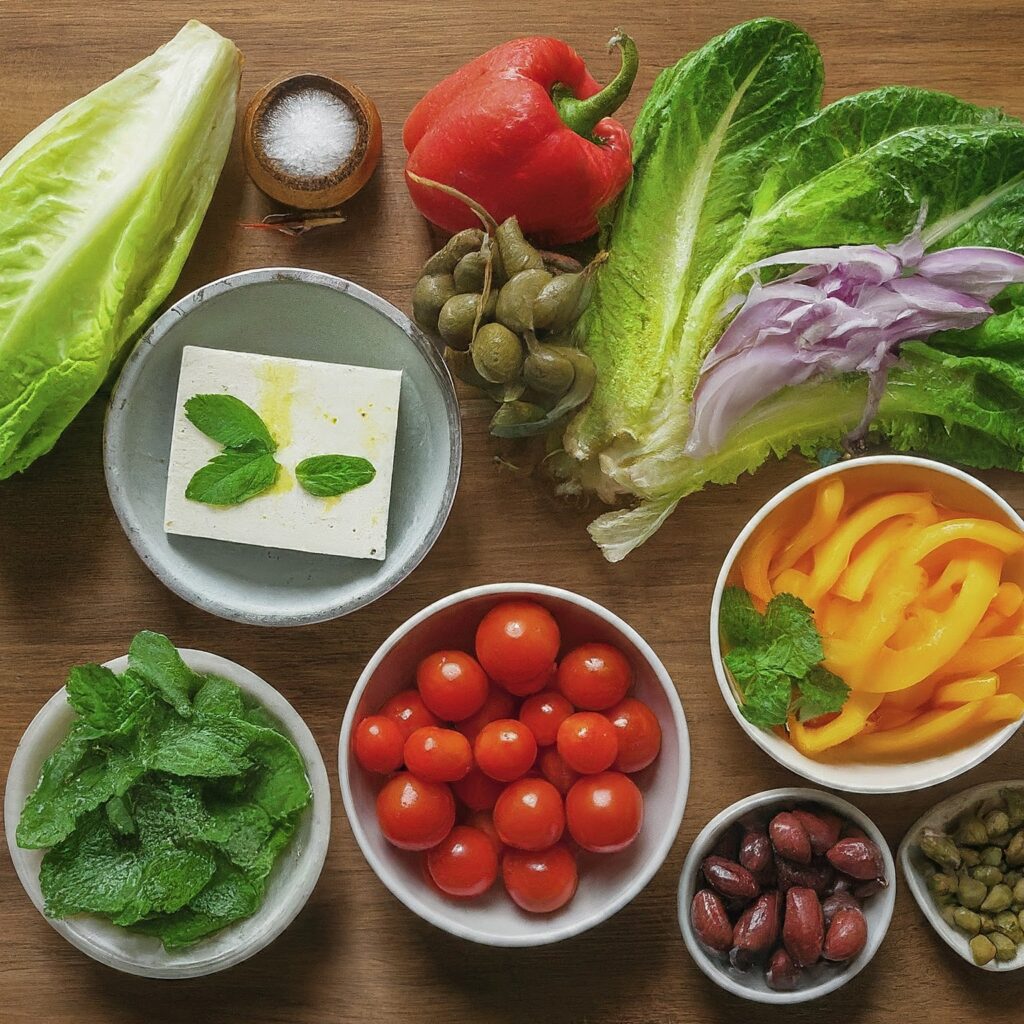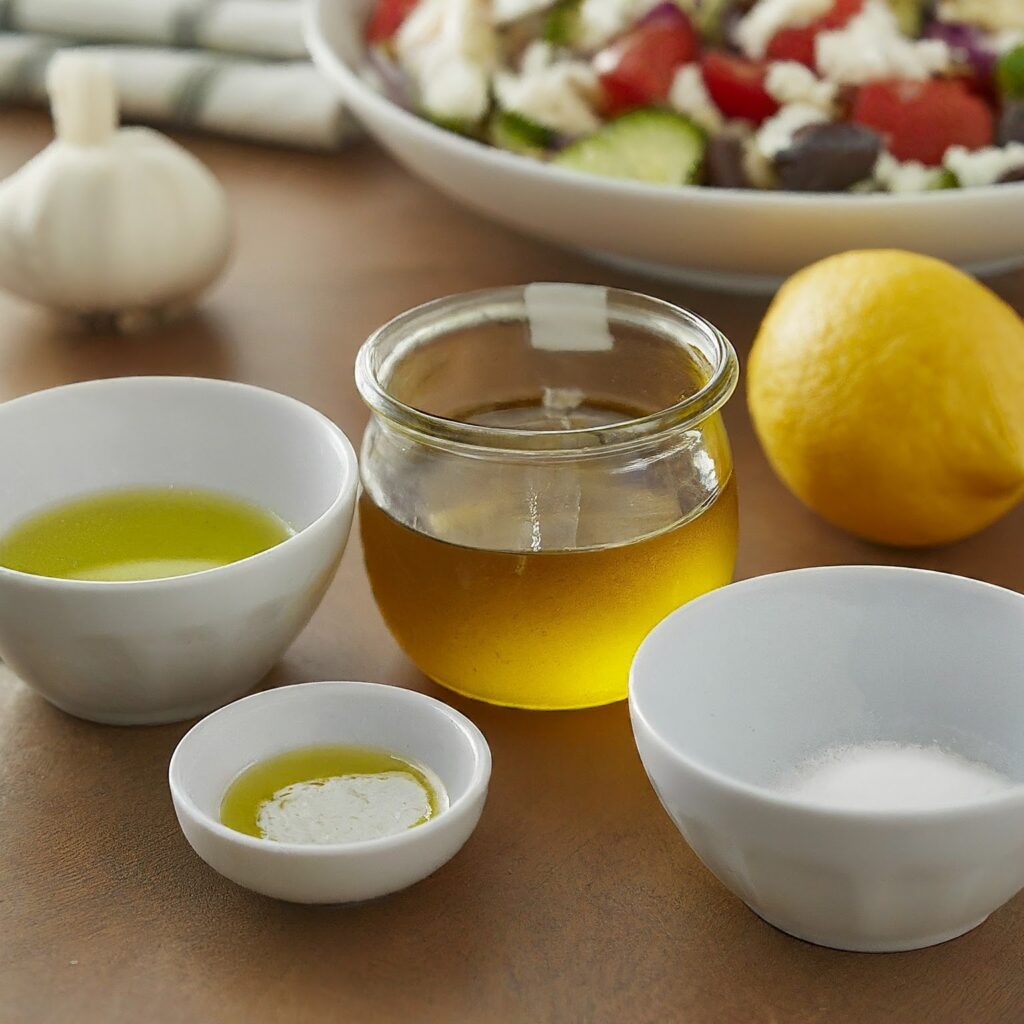Each & Everything Is About The Tastiest Greek Salad
The dazzling flavors of sweet tomatoes, crunchy cucumbers, bell peppers, red onion, olives, and creamy feta cheese come together wonderfully in this dish with Mediterranean influences. The dish gets just the right taste and flavor from the homemade Greek salad dressing.

Greek salads are known for being simple to make and emphasizing seasonal ingredients. Although lettuce isn’t usually used in traditional Horiatiki salads, you can include it if you’d like. It all comes with personal preference and taste. Salads are wonderful because they are easily made fresh or modified to your liking.
The Greek salad is a wonderful substitute for a nutritious and flavorful dinner, especially in the summer when vegetables are at their height. You can also add some lettuce for extra greens. This recipe is easy to make ahead of time and assemble right before serving, making it an ideal pick for meal plans or get-togethers.
If you want to see or buy a quality Oil Sprayer click right here
Basic Ingredients,
The secret to a classic Greek salad is the carefully balanced combination of ingredients. Assume a rainbow made from brightly colored tomatoes, crunchy green bell peppers, crunchy sliced cucumbers, tangy Kalamata olives, and creamy feta cheese. It’s a traditional pairing that never fails to please the palate. Toss in a handful of mint leaves for a pleasant finishing touch that gives the dish a burst of freshness.
When talking about olives, I think Kalamata olives are my particular preference for Greek salad. Known for its flavor that is both briny and salty, this type goes well with the crisp veggies and the creamy feta. I use cherry tomatoes instead of larger ones since they release less water and prevent the salad from being too wet. To keep the desired texture of the salad, I also make sure to seed the cucumbers.

Cut the ingredients into equal-sized pieces for a truly fantastic salad taste. This provides a delicious fusion of flavors with every bite. Instead of crumbling the feta cheese, I like to use cubes, pitted Kalamata olives, and cube it into 1/2-inch chunks. For the bell pepper and cucumber, try for 1-inch squares, thin half-moons, and just cut the cherry tomatoes in half.
Even while romaine lettuce isn’t usually included in classic Greek salads, adding some can improve the dish’s overall flavor. It gives a nice crunch and acts as a binding agent for the dressing.
However, you can leave out the lettuce if you’d like to take a more traditional way. A quick soak in water can help reduce the sharpness of red onions for people who are worried about their strong flavor. While cherry or grape tomatoes provide delicious bursts of sweetness, cucumbers are a perfect complement to the salad due to their refreshing and hydrating characteristics. The green bell pepper gives the dish an additional dose of crunch and freshness.
The pièce de résistance, the feta cheese, should not be missed. Greek salads are known for having their unique taste. You may also try substituting creamy ricotta or grilled halloumi if you’re not a fan of feta.
We’ll Need (As per 4 Serving):

- 2 large cucumbers, seeded and thinly sliced into half-moons
- 1 pint cherry tomatoes, halved
- 1 green bell pepper, sliced into 1-inch squares
- 1 Thinly slice a small red onion and put it in water
- 1 cup kalamata olives, whole or pitted
- 1/2 cup crumbled, feta cheese or half-inch cubes of feta
- A handful of fresh, roughly chopped mint leaves
- 2 tablespoons of capers (Optional)
- Romaine lettuce, torn into bite-sized pieces (amount depends on your liking)

Salad Dressing:
- 1/4 cup extra virgin olive oil
- 2 teaspoons of red wine vinegar or fresh lemon juice
- 1 clove garlic, minced
- Salt and pepper to taste

Preparation:
Mix all the salad ingredients together in a large bowl, including the cucumbers, cherry tomatoes, green bell pepper, red onion, Kalamata olives, feta cheese, mint leaves, and capers if desired. Add the torn romaine lettuce as a basis or combine it with the remaining ingredients.
To make the dressing, whisk olive oil, red wine vinegar or lemon juice, minced garlic, salt, and pepper until thoroughly combined. Spread the dressing over the salad, tossing lightly to coat. Add the seasoning to your taste.

Serve the Greek salad quickly as a tasty and nutritious appetizer or side dish with your main course.
If you want to see or buy a quality Oil Sprayer click right here
Nutrition Facts of Per Serving,
- Calories: 212
- Protein: 4g
- Total Fat: 17g
- Saturated Fat: 4g
- Trans Fat: 0 grams
- Cholesterol: 13mg
- Sodium: 500mg
- Total carbohydrates: 14g
- Dietary Fiber: 4g
- Sugars: 7g
Tips for Choosing Ingredients,
Kalamata olives are the traditional olives used in Greek salads, providing a deliciously salty and rich flavor to the dish. Personally, I prefer using Kalamata olives with seeds as I find they retain more juiciness and flavor. However, if you prefer convenience, you can opt for pitted Kalamata olives.
When it comes to olives, choose darker-colored ones because they have a stronger flavor. If possible, freshly prepared black olives in olive oil from delis are the finest alternative. Otherwise, look for prepackaged olives of good quality. It’s critical to choose plump olives and have a deep black color, as some may have lost color and flavor.
I remember a day when I was in California and went from store to store in search of the ideal olives, much to the frustration of my friend. After a while, I found Delallo olives, which are very good and already packaged. In Australia, Canada, and the UK, you can find good-quality plump Kalamata olives in most large supermarkets.
If you find the rawness of red onion to be too strong for your liking (although red onion is milder compared to other varieties), there’s a simple trick to soften its sharpness. After slicing, submerge the onions in a water bowl for 15-20 minutes. This step will help soften the flavor and make it more enjoyable.
The number of calories per serving can be lowered to about 300 if low-fat feta cheese is used. Still, I have to say that the full-fat feta cheese gives the salad a lovely richness that makes it really tasty.
What to Serve with Greek Salad?
Chicken: Greek salad is a flexible dish that pairs well with many main dishes. Serve it with Baked or Air-Fried Chicken Breast for a high-protein dinner. The juicy and tasty chicken complements the salad’s fresh ingredients, creating a pleasant and balanced lunch. Also the Grilled Chicken Souvlaki, with tender and savory marinated chicken skewers, adds a pleasing contrast to the salad’s freshness.
Mediterranean Theme: To keep with the Mediterranean theme, you might pair Greek salad with Greek Stuffed Peppers. These tasty peppers are packed with a flavorful combination of rice, herbs, and, on occasion, ground beef. The vibrant salad and flavorful stuffed peppers will surely please your taste buds.
Bread: The ideal option would be a slice of No Knead Focaccia. The meal is made better by the exquisite texture and flavor of the soft and fluffy bread, which is infused with olive oil and flavored with fresh herbs. Greek salad pairs well with pita bread and hummus for a traditional and filling side dish.
Fish: Greek salad goes well with baked salmon or grilled swordfish if you’re a seafood enthusiast. The crispness and tanginess of the salad blend with the smokey char from the grill or the soft flakiness of the baked fish to create a delicious blend of flavors. Greek salad is spiced up by grilled shrimp, calamari, or fish that has been seasoned with lemon and herbs. The sharpness of the salad and the grilled seafood provide a pleasant balance that blends the tastes together nicely.
Lamb: Warm pita bread with lamb gyros, lettuce, tomatoes, onions, and tzatziki sauce wrapped inside. The crisp Greek salad and the tender, spiced, roasted lamb slices complement each other so well that they become a gastronomic match made in heaven.
If you want to see or buy a quality Oil Sprayer click right here
Storage Tips,
- Any leftover Greek salad should be quickly refrigerated to maintain its freshness after serving. Store the salad bowl in an airtight container or cover it tightly with plastic wrap.
- Store any leftover dressing separately to avoid the salad from becoming overly soggy. Drizzle the salad with the dressing right before serving.
- Remove any leafy greens from your Greek salad that might wilt before storing the leftovers. When ready to eat, add the greens back after storing them separately.
- To maintain its freshness, store Greek salad in the refrigerator’s coldest section, such as the crisper drawer or bottom shelf.
- Greek salad is best eaten within 2-3 days of preparation due to the flavor and texture of the ingredients.
- Pre-slice the items 1 to 2 days ahead of time and toss them together on the day of serving.
Leftover Uses,
Greek Salad Wrap: Take some whole wheat tortillas or flatbreads and stuff them with the remaining Greek salad. For added protein, try adding some grilled chicken or chopped lamb gyro meat. Roll it up for a delicious and refreshing Greek salad wrap.

Greek Salad Pasta: Cook your favorite pasta, like penne or fusilli, according to the package directions. Toss the cooked pasta with the leftover Greek salad, adding extra olive oil and lemon juice if needed. You can also add crumbled feta cheese on top. Serve chilled as a delicious pasta salad.

Greek Salad Pizza: Use the leftover Greek salad to top a handmade or store-bought pizza. Spread some tomato sauce or pesto on the pizza crust, then top it with shredded mozzarella cheese and Greek salad. For a Mediterranean-inspired pizza, bake until the cheese melts and bubbles.

Greek Salad Quinoa Bowl: After cooking the quinoa as directed on the package, let it cool. Toss the cooked quinoa and leftover Greek salad in a bowl. To add flavor, sprinkle with additional dressing or lemon juice. This makes for a wholesome and satisfying grain bowl.

Tips & Tactics,
- As directed, chop each and every salad ingredient. Mix the dressing and store it in a jar. Store each component in an airtight container and keep it chilled until you’re ready to assemble.
- Feta should be used in the brine, not already crumbled. The crumbled kind lacks flavor and is somewhat drier.
- For a meal prep lunch, arrange the crisp veggies, olives, and lettuce in a mason jar starting at the bottom and layering them with feta and dressing. When it’s time to dine, put the salad in a bowl and toss to combine the dressing evenly.
Always keep clean your hands & for that you can check this soap dispenser right here








3 Comments